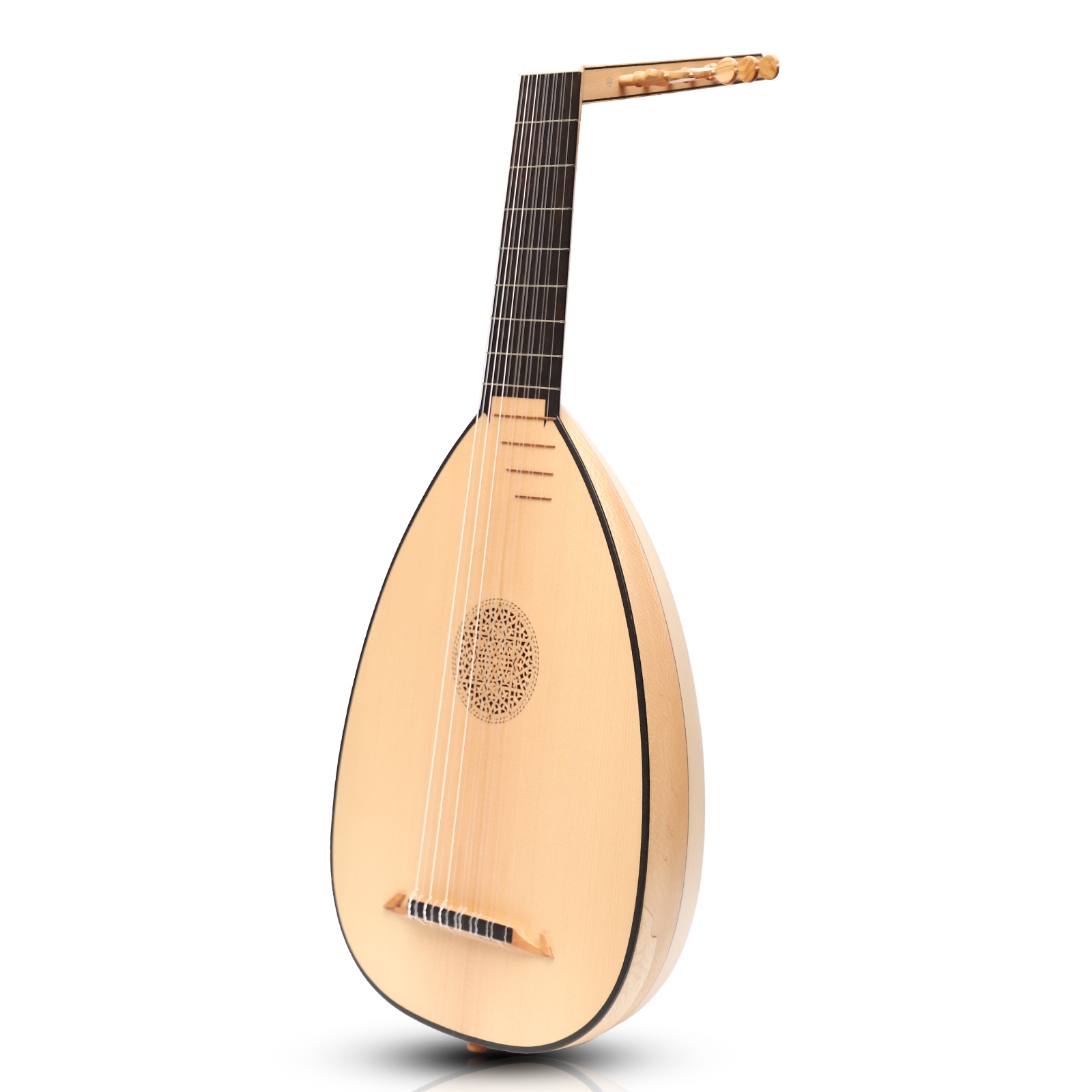Lute – Stringed Instrument
History of Lute
The lute is a plucked stringed musical instrument that is believed to have originated in the Middle East during the 9th century. It was brought to Europe during the medieval period and became one of the most popular instruments of the Renaissance.
The early versions of the lute were small and had a pear-shaped body with a rounded back. It had four or five courses of strings (pairs of strings that are tuned to the same pitch) that were made of gut, silk or metal. The strings were plucked with a plectrum or with the fingers.
Over time, the lute evolved and became larger, with a wider range of strings and more complex tuning. By the 16th century, the lute had become a popular instrument among the nobility and the wealthy in Europe, and many composers, such as John Dowland, used it to compose music.
During the Baroque period, the lute gradually fell out of favor as other instruments such as the violin, harpsichord, and guitar gained popularity. However, it continued to be used in folk music and in some classical compositions.
Today, the lute is still played by musicians who specialize in early music, and there are several different types of lutes, including the Renaissance lute, the Baroque lute, and the theorbo. It remains a fascinating and beautiful instrument, and its history is an important part of the development of Western music.
Material used in Lute
Traditionally, lutes were made from a variety of materials, including:
Wood: The body, neck, and pegbox of the lute were typically made from hardwoods such as maple, ebony, or rosewood. Softwoods like spruce or cedar were used for the soundboard.
Gut: The strings of the lute were made from animal gut (usually sheep or goat), which was dried and twisted to create a strong, flexible string.
Horn or ivory: The frets on early lutes were made from animal horn or ivory, which were cut into small pieces and glued onto the fingerboard.
Metal: Later lutes often used metal strings, and metal frets (usually made from brass or silver) replaced the horn or ivory frets.
Today, lutes are still made using similar materials, although synthetic materials may be used in place of natural gut strings. Some modern luthiers also experiment with alternative materials, such as carbon fiber or Kevlar, which can offer different tonal qualities and structural benefits.
Types of Lute
There are several types of lute that have evolved over the centuries. Here are some of the most common types:
Renaissance Lute: This is the most well-known type of lute, and it was popular in Europe during the Renaissance period. It typically has a rounded back and a pear-shaped body, with a fretted neck and six to ten pairs of strings.
Baroque Lute: The Baroque lute was popular in the 17th and 18th centuries, and it has a longer neck and a wider fingerboard than the Renaissance lute. It also has more strings, typically with a range of 13 to 14 courses.
Archlute: The archlute is a type of Baroque lute with an extended bass range. It has a longer neck and a larger body, with additional bass strings that are strung on a separate extension attached to the body.
Theorbo: The theorbo is a large, long-necked lute that was developed in the Baroque era. It has an extra set of bass strings, which are tuned to lower notes than the other strings, and a very long neck that extends upward above the head of the instrument.
Chitarrone: The chitarrone is a large Baroque lute that was developed in Italy. It has a long, wide neck and an extended bass range, with up to 14 courses of strings.
Mandolin-banjo Lute: This is a modern type of lute that combines elements of the mandolin, banjo, and lute. It typically has a small, round body and a short neck with a fretted fingerboard.
Lute Harp: The lute-harp, also known as the Irish harp or the cláirseach, is a type of harp that has a similar shape and construction to the lute. It has a rounded back and a narrow, curved neck, and it is typically played with the fingers or a small plectrum.
These are just a few examples of the many types of lutes that exist. Each type of lute has its own unique characteristics and playing style, and each has played an important role in the development of Western music.
Countries having rich heritage of Lute
The lute has a rich history and has been played in many different countries and regions throughout history. Some of the countries where the lute has been particularly popular include:
- Italy: Italy was a major center of lute playing during the Renaissance, and many of the greatest lute composers of the time were Italian.
- France: The lute was also popular in France during the Renaissance and Baroque periods. French lute music is characterized by its intricate ornamentation and complex rhythms.
- England: The lute was an important instrument in Elizabethan England, and it was often played as a solo instrument or as part of an ensemble.
- Spain: The lute was popular in Spain during the Renaissance and Baroque periods, and it was often played in conjunction with the vihuela, a type of guitar-like instrument.
- Middle East: The lute has a long history in the Middle East, where it is known as the oud. The oud is a pear-shaped instrument with a short neck and gut strings, and it is commonly used in Arabic, Turkish, and Persian music.
- Central Asia: The lute has been a popular instrument in Central Asia for centuries, and it is known as the dutar. The dutar is a two-stringed instrument with a long neck and a round body, and it is commonly used in traditional Central Asian music.
- Ireland: The lute-harp has a long history in Ireland, where it was traditionally used as a solo instrument and as an accompaniment to singing. It was also played in courts and aristocratic households, and it was often depicted in illuminated manuscripts and other works of art.
Today, the lute-harp remains an important instrument in traditional Irish music. It is often played at weddings, funerals, and other important events, and it is also used in recordings and live performances by contemporary Irish musicians.
One of the most famous lute-harp players in history was Turlough O'Carolan, an Irish composer who lived in the 17th and 18th centuries. O'Carolan wrote hundreds of pieces for the lute-harp, many of which are still played and celebrated today.
These are just a few examples of the many countries where the lute has been an important instrument throughout history. Today, the lute is still played in many different parts of the world, and it continues to be an important instrument in both classical and folk music traditions.
Lute for Fun
The lute can be a very rewarding instrument to play for pleasure. It has a beautiful, rich tone and a unique sound that can be quite mesmerizing. Additionally, playing the lute can be a meditative and relaxing activity, as the player focuses on the intricate fingerwork required to produce the desired sounds.
For those who are interested in learning to play the lute for pleasure, there are a variety of resources available. Many music schools and conservatories offer classes and lessons in lute playing, and there are also a number of online resources available, including instructional videos, sheet music, and forums where lute players can connect and share their experiences.
In addition to learning to play the lute, listening to lute music can also be a pleasurable experience. There are many great lute composers from throughout history, including John Dowland, Francesco da Milano, and J.S. Bach, among others. Exploring the works of these and other lute composers can be a rewarding way to deepen one's appreciation for the instrument and its music.

-MOB-min.jpg?1640433452870)




